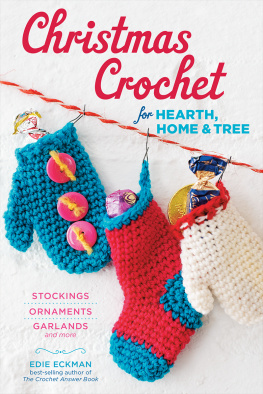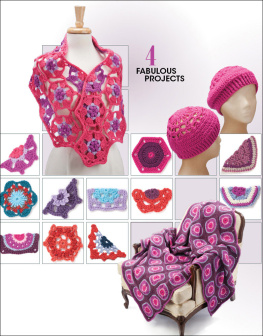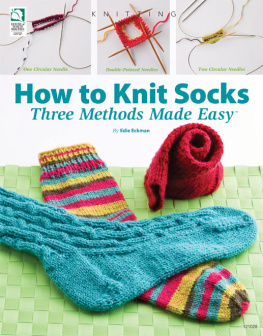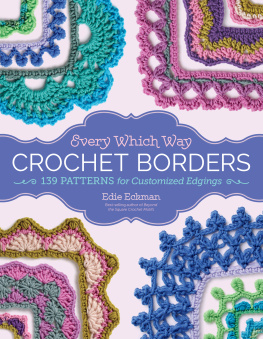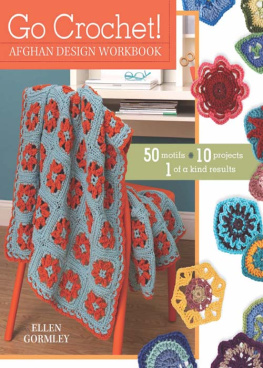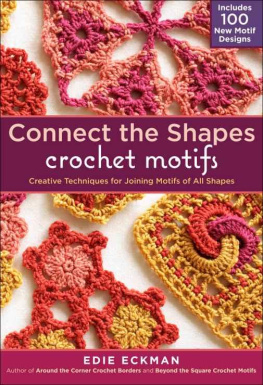Connect the Shapes
CROCHET MOTIFS


Connect the Shapes
CROCHET MOTIFS
CREATIVE TECHNIQUES FOR
JOINING MOTIFS OF ALL SHAPES
EDIE ECKMAN

To Ann with love
The mission of Storey Publishing is to serve our customers by
publishing practical information that encourages
personal independence in harmony with the environment.
Edited by Gwen Steege and Pam Thompson
Art direction and book design by Carolyn Eckert
Text production by Jennifer Jepson Smith
Cover photography by John Polak Photography,
except for authors photograph by Charles Eckman
Interior photography by John Polak Photography,
except for pages ,
by
Chattman Photography, pages bottom,
row 4, center by Mars Vilaubi, page bottom by
Myra Wood and page top courtesy of the author.
Charts by Karen Manthey
Indexed by Christine R. Lindemer,
Boston Road Communications
Tech edited by Karen Manthey
2012 by Edie Eckman
All rights reserved. No part of this book may be reproduced without written permission from the publisher, except by a reviewer who may quote brief passages or reproduce illustrations in a review with appropriate credits; nor may any part of this book be reproduced, stored in a retrieval system, or transmitted in any form or by any means electronic, mechanical, photocopying, recording, or other without written permission from the publisher.
The information in this book is true and complete to the best of our knowledge. All recommendations are made without guarantee on the part of the author or Storey Publishing. The author and publisher disclaim any liability in connection with the use of this information.
Storey books are available for special premium and promotional uses and for customized editions. For further information, please call 1-800-793-9396.

Storey Publishing
210 MASS MoCA Way
North Adams, MA 01247
www.storey.com
Printed in China by Toppan Leefung Printing Limited
10 9 8 7 6 5 4 3 2 1
Library of Congress Cataloging-in-Publication Data
Eckman, Edie.
Connect the shapes crochet motifs / by Edie Eckman.
pages cm
Includes index.
ISBN 978-1-60342-973-3 (hardcover with concealed
wire-o: alk. paper)
1. CrochetingPatterns. I. Title.
TT820.E349 2012
746.434dc23
2012013934
Contents
PART II
MOTIFS AND JOINS
PART III
PATTERNS

introduction

connected along edges
CROCHETED MOTIFS CONTINUE TO FASCINATE US. They can be used on their own for embellishments, or repeated and combined to create larger projects. They are usually (but not always) worked in the round from the center out. The most common crochet motif is the granny square (see ). Indeed, the term granny square is often used to mean any square crocheted unit worked in the round. Here, I use the word motif instead, because they can be so many more shapes than square, and they certainly arent confined to grannies!
What is it about the use of color, shape, and texture that grabs our interest and makes us willing to stitch the same motif over and over again? Perhaps it is the repetition itself that is so soothing, or the almost instant gratification that we get from seeing a project (or at least part of a project) begun and ended in such a short amount of time. Perhaps it is the ability to play with color, without fear of wasting too much time or yarn if the results are not what we would like. Or perhaps it is the construction of a whole from individual units that appeals to us, evoking the puzzles and blocks of our childhoods.
Many crocheters love to stitch motifs but dread the process of joining them. Connecting one motif to another or many motifs to each other doesnt have to be the most-feared and least-looked-forward-to aspect of a crochet project. In fact, it can be as exhilarating as the stitching! And because crochet is so versatile, we dont have to stick to joining pieces only at their points or edges. We can layer motifs or add filler motifs. We can connect motifs on more than one round or join them internally, creating entire fabrics that are joined together as part of their essential structure.

connected with a filler motif

connected in layers
Nothing New under the Sun?
In design, it is difficult to say that something is completely original. Many traditional motifs share traits that are universally appealing, and we are all influenced by what we see around us. When I say a design is original, I mean that I have received a particular input, my brain filtered it, and the output appeared on my hook; I have not copied or adapted anothers design. Nevertheless, I may not be the first to stitch a particular design, and I certainly hope I wont be the last!
In Connect the Shapes Crochet Motifs, I build on what I started in my first book about motifs. In Beyond the Square Crochet Motifs, I explored a variety of shapes, colors, and textures, and experimented with techniques to improve the look of the motif. In Connect the Shapes, I gather motifs in families and explore ways of joining them to each other. The families usually begin with a motif originally designed for this book. From this starting point, I vary stitches and colors, add corners, textures, and layers, and otherwise morph the original into new motifs. These may resemble each other in the way of close siblings or somewhat distant cousins. Joining the motifs in new and surprising ways carries them even further from their origins, and in this book I delve into many methods of joining, exploring both the design and technical aspects of creating a whole fabric from individual units. And finally, I include projects that demonstrate some practical uses for these connection methods.
Connect the Shapes is meant to be a jumping-off point for your own creativity. Make the projects in the book, by all means, but more importantly, study the techniques, examine the samples, and try your own variations in order to fashion your own beautiful one-of-a-kind creations!
Next page

